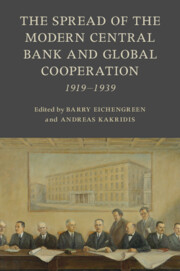Book contents
- The Spread of the Modern Central Bank and Global Cooperation
- Studies in Macroeconomic History
- The Spread of the Modern Central Bank and Global Cooperation
- Copyright page
- Contents
- Figures
- Tables
- Editors and Contributors
- Preface
- Part I General
- Part II Specific
- 5 Central Bank Policy under Foreign Control
- 6 Sneaking Nationalization
- 7 The Bank of Poland and Monetary Policy during the Interwar Period
- 8 From Banking Office to National Bank
- 9 ‘Nobody’s Child’
- 10 The Bulgarian National Bank, 1926–1935
- 11 Macroeconomic Policies and the New Central Bank in Turkey, 1929–1939
- 12 Latin American Experiments in Central Banking at the Onset of the Great Depression
- 13 Central Banks in the British Dominions in the Interwar Period
- 14 Central Banking and Colonial Control
- Index
- References
10 - The Bulgarian National Bank, 1926–1935
Revamping the Institution, Addressing the Depression
from Part II - Specific
Published online by Cambridge University Press: 02 November 2023
- The Spread of the Modern Central Bank and Global Cooperation
- Studies in Macroeconomic History
- The Spread of the Modern Central Bank and Global Cooperation
- Copyright page
- Contents
- Figures
- Tables
- Editors and Contributors
- Preface
- Part I General
- Part II Specific
- 5 Central Bank Policy under Foreign Control
- 6 Sneaking Nationalization
- 7 The Bank of Poland and Monetary Policy during the Interwar Period
- 8 From Banking Office to National Bank
- 9 ‘Nobody’s Child’
- 10 The Bulgarian National Bank, 1926–1935
- 11 Macroeconomic Policies and the New Central Bank in Turkey, 1929–1939
- 12 Latin American Experiments in Central Banking at the Onset of the Great Depression
- 13 Central Banks in the British Dominions in the Interwar Period
- 14 Central Banking and Colonial Control
- Index
- References
Summary
The Bulgarian National Bank (BNB) was restructured repeatedly between 1926 and 1935, but these restructurings were superficial and incoherent, producing contradictory outcomes. The liberal spirit of the initial 1926-8 reforms dissolved with the onset of the Great Depression. Subsequently, the BNB was endowed with new instruments and tasked with carrying out the interventionist policies adopted in the 1930s, thus paving the way for the bank’s eventual role in the communist planned economy. This chapter focuses on the significance of BNB’s state ownership and on the tight economic conditionality attached to 1926 and 1928 loans sponsored by the League of Nations. By contrasting policies followed in Bulgaria and Greece during the Depression, it challenges Eichengreen’s hypothesis that heavy defaulters and countries leaving the gold exchange standard performed better relative to those that sought to maintain their reputations as decent debtors.
Keywords
- Type
- Chapter
- Information
- The Spread of the Modern Central Bank and Global Cooperation1919–1939, pp. 268 - 300Publisher: Cambridge University PressPrint publication year: 2023

